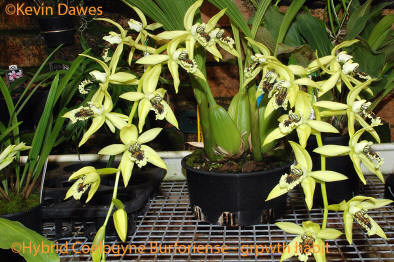Coelogyne Burfordiense is a really big robust plant in Coelogyne terms, and was formally bred and registered in England in 1911 by Sir Trevor Lawrence, despite the fact that it has been found occurring naturally. It was produced from pod parent Coelogyne asperata and Coelogyne pandurata.
Over the intervening 100 years this hybrid has remained common in collections. It has very large displays of arching to pendulous spikes with huge light green flowers. This hybrid certainly makes an eye-catching display.
I have bought several plants labeled as Coelogyne pandurata, only to find that when they flower they are actually the above hybrid. This is a common event, apparently, at least in Australia. The resulting frustration leaves me with negative feelings against this hybrid. There are some other very pretty green flowering orchids such as the smaller, daintier Coelogyne brachyptera, virescens and mayeriana. I would like to have a proper Coelogyne pandurata and have a variety of new plants from a range of sources. However, they are yet to flower.
There are some differences between Coelogyne Burfordiense and Coelogyne pandurata but the green Coelogynes as a group tend to cause a lot of confusion.
Coelogyne asperata gives the hybrid its rounded side lobes and brown warts on the keels of the lip. Coelogyne pandurata has more sharply pointed side lobes on the lip and the mass of molar-like warts are cream to white in colour and with not a hint of brown.
N.B. Note the white markings on the bottom of the pot in the left image. This is salt build-up caused by very heavy watering. It is growing in large chunks of coconut husk which retains lots of moisture but maintains its free draining character. Apart from daily overhead sprinklers, it is in a glass house where foggers run for many hours of the day to they keep the humidity really high. As long as they are really well drained, most Coelogynes love these conditions (as evidenced by the plant above!) and especially Dendrochilums. In this situation, sphagnum moss needs to be managed very carefully because it doesn't drain. Note also the algae growing on the brick background.
Negatives: It needs a fair bit of room.
Rating: ♦♦♦♦
Sometimes sold as: Coelogyne pandurata! It is also known as Coelogyne Stanny (the natural hybrid).
Varieties: None known
Hybrids:
- Coelogyne South Carolina (Carter and Holmes, 1996) - using Coelogyne pandurata as the pollen parent. This secondary hybrid should have less steroids, be greener and have a purer black on the lip). However, I don't own one as yet.
- Coelogyne Beatrice Schmidt (L. Amazone, 2012) - using Coelogyne veluntina as the pollen parent.
| < Coel Bird in Flight | Coel Edward Pearce > |
